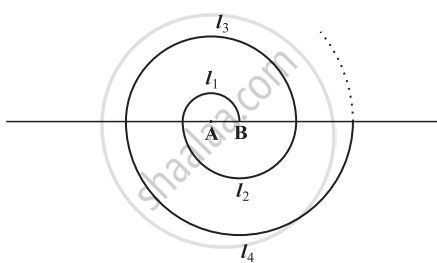Advertisements
Advertisements
Question
Determine the A.P. whose 3rd term is 16 and the 7th term exceeds the 5th term by 12.
Solution
We have given a3 = 16
a + (3 − 1)d = 16
a + 2d = 16(1)
a7 − a5 = 12
[a + (7 − 1)d] − [a + (5 − 1)d] = 12
(a + 6d) − (a + 4d) = 12
2d = 12
d = 6
From equation (1), we obtain
a + 2(6) = 16
a + 12 = 16
a = 4
Therefore, A.P. will be 4, 10, 16, 22, ...
APPEARS IN
RELATED QUESTIONS
The houses in a row numbered consecutively from 1 to 49. Show that there exists a value of x such that sum of numbers of houses preceding the house numbered x is equal to sum of the numbers of houses following x.
Check whether -150 is a term of the A.P. 11, 8, 5, 2, ....
A spiral is made up of successive semicircles, with centres alternately at A and B, starting with centre at A of radii 0.5, 1.0 cm, 1.5 cm, 2.0 cm, .... as shown in figure. What is the total length of such a spiral made up of thirteen consecutive semicircles? (Take `pi = 22/7`)

[Hint: Length of successive semicircles is l1, l2, l3, l4, ... with centres at A, B, A, B, ... respectively.]
The sum of three terms of an A.P. is 21 and the product of the first and the third terms exceed the second term by 6, find three terms.
Find the sum of the following arithmetic progressions:
41, 36, 31, ... to 12 terms
Find the sum of the first 22 terms of the A.P. : 8, 3, –2, ………
The first and the last terms of an A.P. are 34 and 700 respectively. If the common difference is 18, how many terms are there and what is their sum?
If the pth term of an AP is q and its qth term is p then show that its (p + q)th term is zero
In a flower bed, there are 43 rose plants in the first row, 41 in second, 39 in the third, and so on. There are 11 rose plants in the last row. How many rows are there in the flower bed?
If (3y – 1), (3y + 5) and (5y + 1) are three consecutive terms of an AP then find the value of y.
Find the value of x for which (x + 2), 2x, ()2x + 3) are three consecutive terms of an AP.
Show that `(a-b)^2 , (a^2 + b^2 ) and ( a^2+ b^2) ` are in AP.
The sum of first three terms of an AP is 48. If the product of first and second terms exceeds 4 times the third term by 12. Find the AP.
Find the sum of the first n natural numbers.
The next term of the A.P. \[\sqrt{7}, \sqrt{28}, \sqrt{63}\] is ______.
Write an A.P. whose first term is a and common difference is d in the following.
a = 6, d = –3
Choose the correct alternative answer for the following question .
If for any A.P. d = 5 then t18 – t13 = ....
If the sum of a certain number of terms starting from first term of an A.P. is 25, 22, 19, ..., is 116. Find the last term.
Find the sum of n terms of the series \[\left( 4 - \frac{1}{n} \right) + \left( 4 - \frac{2}{n} \right) + \left( 4 - \frac{3}{n} \right) + . . . . . . . . . .\]
In an A.P., the first term is 22, nth term is −11 and the sum to first n terms is 66. Find n and d, the common difference
A man is employed to count Rs 10710. He counts at the rate of Rs 180 per minute for half an hour. After this he counts at the rate of Rs 3 less every minute than the preceding minute. Find the time taken by him to count the entire amount.
The first and last term of an A.P. are a and l respectively. If S is the sum of all the terms of the A.P. and the common difference is given by \[\frac{l^2 - a^2}{k - (l + a)}\] , then k =
If the sum of first n even natural numbers is equal to k times the sum of first n odd natural numbers, then k =
If the first term of an A.P. is 2 and common difference is 4, then the sum of its 40 terms is
An article can be bought by paying Rs. 28,000 at once or by making 12 monthly installments. If the first installment paid is Rs. 3,000 and every other installment is Rs. 100 less than the previous one, find:
- amount of installments paid in the 9th month.
- total amount paid in the installment scheme.
For an A.P., If t1 = 1 and tn = 149 then find Sn.
Activitry :- Here t1= 1, tn = 149, Sn = ?
Sn = `"n"/2 (square + square)`
= `"n"/2 xx square`
= `square` n, where n = 75
Find t21, if S41 = 4510 in an A.P.
Find the sum of all the 11 terms of an AP whose middle most term is 30.
Find the sum of those integers between 1 and 500 which are multiples of 2 as well as of 5.
Find the sum of first 16 terms of the A.P. whose nth term is given by an = 5n – 3.
